Control Room |
|---|
This compartment is the heart of the submarine. The two large brass wheels on the port side in the center of the Control Room plus the two little handles between the wheels, the depth gauges and gauges for telling angles of the boat were all used and operated by two men, the Bow Planesman and the Stern Planesman. They worked as a team to control the depth of the submarine when submerged.
The little black box hanging from the overhead in the upper right of the image below, is called a Bathythermograph. Although this device does not look very important it remained a military secret for some time after the end of WW-II. This instrument simultaneously records both the depth and temperature of the water just outside the submarine. A 'kink' in the line being drawn as the submarine changes depth indicates a 'thermocline' or region of large temperature change. Sound waves are deflected by thermoclines so a submarine can sometimes hide beneath them out of 'sight' of the probing 'pings' from an enemy's sonar.
The large brass wheel forward and centered in the Control Room was used for steering when under depth charge attack and running silent. This large brass wheel along with the two large wheels for the Bow Planes and Stern Planes, were also brought into use under these conditions. This was very hard and hot work. The noisy ventilation system would be shut off and temperature of 130 degrees and higher were not uncommon. This ordeal sometimes lasted as long as thirty hours.
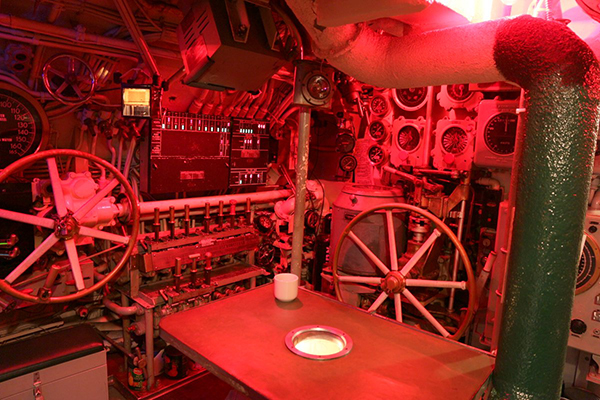 |
|---|
The photo below, taken during WW-II, shows two crewmen operating Cod's bow planes and the Main Ballast Control panel (known as the "Christmas Tree" because of its red and green indicator lights). Pulling the levers causes the vents at the top of the ballast tanks to open which results in water flooding the vented tanks and thus causing the submarine to loose buoyancy and dive.
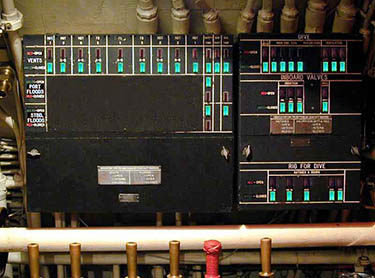 |
|---|
This compartment also contains the controls for forcing air back into the ballast tanks and thus pushing out the water. This causes the boat to again become buoyant enough to rise to the surface. The photo below shows a portion of the high pressure blow manifold and the associated pressure gauges. Note that many of the gauges are "red lined" at 3,000 psi (pounds per square inch).
Maintaining the submarine in a level condition and adjusting the overall weight of the submarine is accomplished by shifting water among various special tanks and the sea. The Trim Manifold located in this compartment provides the means for directing the appropriate amount of water between these tanks and/or the sea. The water is moved by the Trim Pump, located in the lower section of this compartment just below the Trim Manifold . The two images below show the gauges that tell how much water weight is in each of these tanks (in thousands of pounds), and the Trim Manifold that controls the way the various tanks are connected together to make the adjustments in weight.
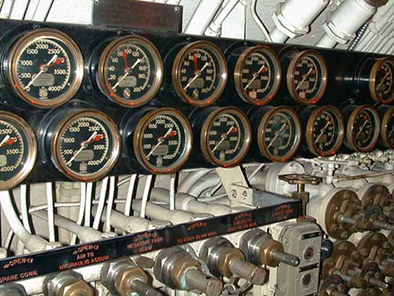 |
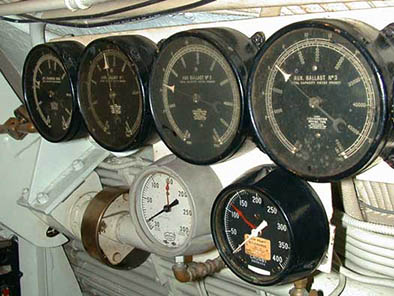 |
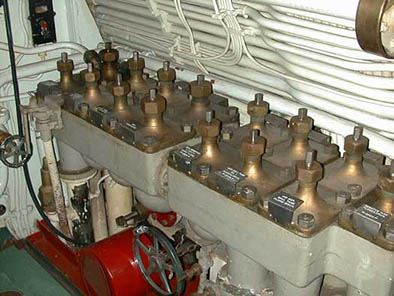 |
Also located just inboard of the diving station is the ladder to the Conning Tower. Located in the Conning Tower are the two periscopes, the Torpedo Data Computer, the RADAR and SONAR consoles, and the control panel for firing the torpedos.
At the after end of the Control Room is the Radio Room containing Cod's communications equipment. Also located in this room is the locked cabinet that housed Cod's "code machine". Developed just before America's entry into World War II for use by both the Army and the Navy, this Electric Cipher Machine proved to be far superior to its counterparts used by the enemy. No signal encoded by this machine was ever broken by the enemy. Called the ECM, Mark II by the Navy and SIGABA by the Army, the machine could quickly encode or decode Morse Code radio messages, printing the decoded text on white adhesive tape which was then stuck to a message sheet. The ECM, Mark II was stored in the gray armored safe just inside the radio room door and was affixed to the inside surface of the top pull-down drawer (red handle). Only used by officers, the ECM, Mark II required the use of special settings which were changed daily. In the event the submarine was sent into shallow enemy waters (less than 100 fathoms, or 600 ft) the code machine was removed from the boat or tossed overboard while still in deep water to prevent its recovery by the enemy if the submarine was sunk. The code machine was replaced in 1959 by electronic machines capable of much faster data transfer rates.
For a 360-degree panorama view of the Control Room showing how it looks with the red lights providing most of the illumination click HERE
Note: This is a large QuickTime VR file and will take some time to download.
Below the deck in the Control Room is the Pump Room. This space contains the pumps and motors for shifting water in the submarine or pumping it overboard. This "trim system" provides a means for adjusting Cod's overall buoyancy and her fore and aft balance. Also located here are pumps for moving oil and two air compressors which provide the high-pressure air needed for surfacing and running the boat. These are quite large and provide air at a pressure of 3000 psi (pounds per square inch) to banks of large air bottles (or flasks) located outside the pressure hull within the ballast tanks.
High-volume, low-pressure blowers located in this space are used to force the last of the water from the ballast tanks when surfacing so as to conserve high-pressure air.
Also located here are the refrigeration compressors that are a part of the food storage and humidity control systems aboard the submarine. Also located in this space is the hydraulic IMO pump and accumulator that provides high-capacity hydraulic power for raising and lowering the periscopes and radar mast, moving the ship's rudder and bow and stern planes, and operating a number of valves and other hydraulic systems.
For a QuickTime VR view of the Pump Room click here: Pump Room (below Control Room)